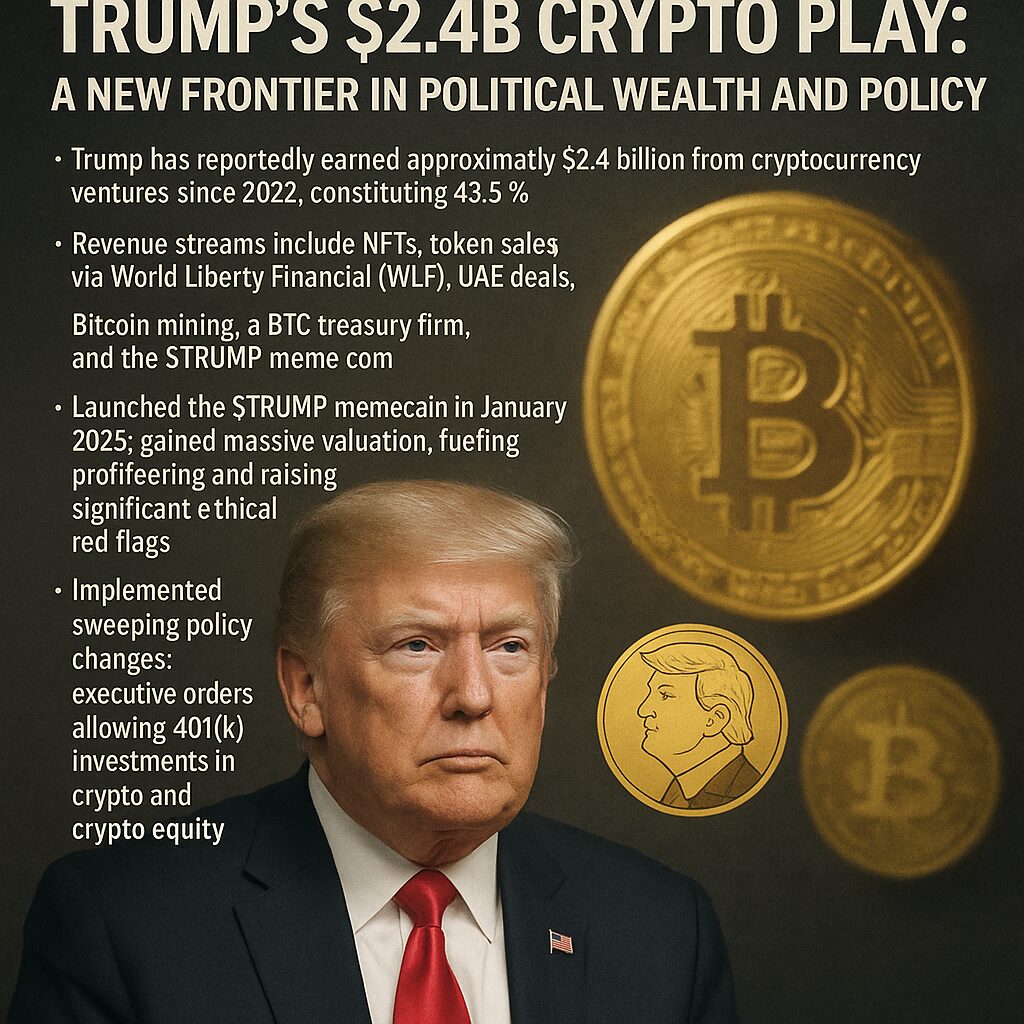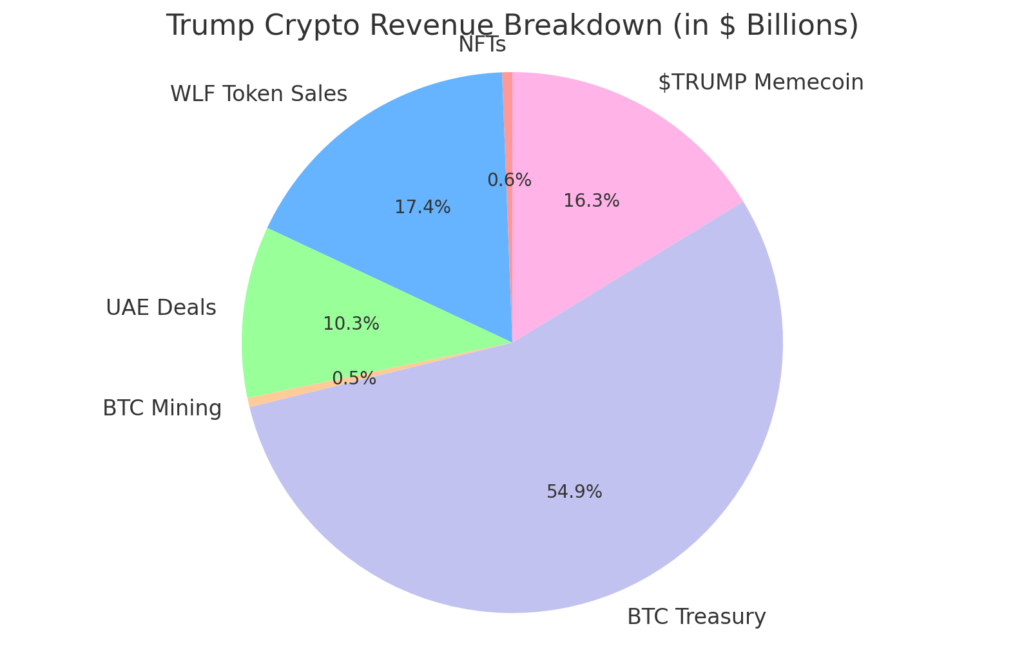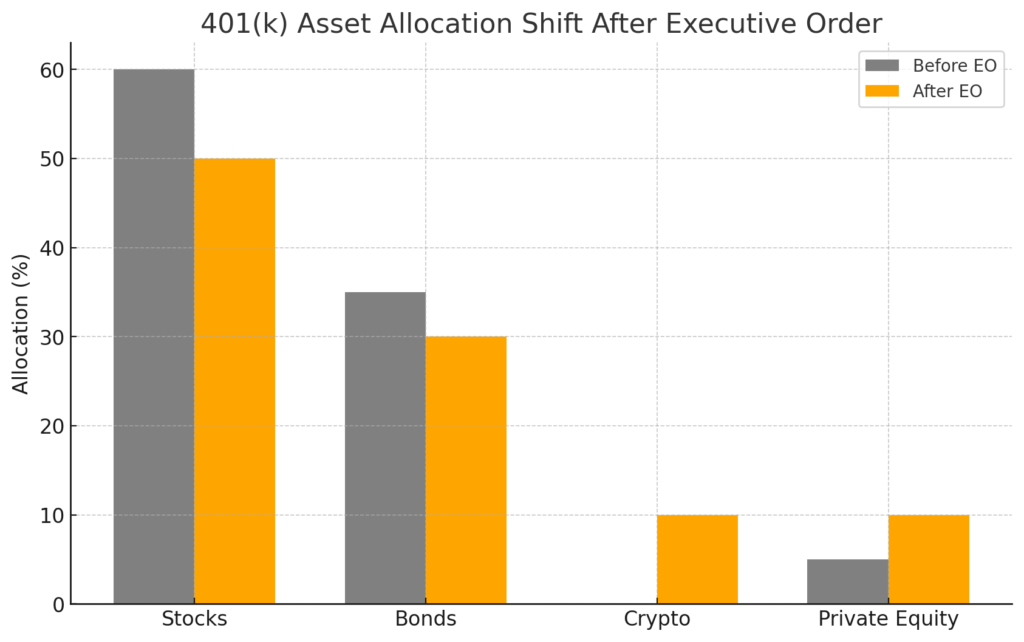
Main Points :
- Trump has reportedly earned approximately $2.4 billion from cryptocurrency ventures since 2022, constituting 43.5% of his political-era wealth.
- Revenue streams include NFTs, token sales via World Liberty Financial (WLF), UAE deals, Bitcoin mining, a BTC treasury firm, and the $TRUMP meme coin.
- Launched the $TRUMP memecoin in January 2025; gained massive valuation, fueling profiteering and raising significant ethical red flags.
- The Trump–WLF ecosystem includes partnerships and stablecoin projects (e.g. USD1), drawing scrutiny for conflicts of interest and foreign influence.
- Implemented sweeping policy changes: executive orders allowing 401(k) investments in crypto and private equity, plus deregulation of crypto firms.
- These moves have sparked regulatory realignments and a clash between traditional finance and a growing crypto ecosystem.
1. Trump’s Crypto Windfall: Diversified Income Streams
Since 2022, Donald Trump’s foray into digital assets has paid off handsomely—an estimated $2.4 billion in profit from crypto-related ventures. Breaking down the major sources:
- $14.4 million from NFT collections
- $412.5 million from token sales via World Liberty Financial
- $243 million from deals with the UAE
- $13 million from the Bitcoin mining company American Bitcoin
- $1.3 billion from a BTC treasury operation under Trump Media & Technology Group
- $385 million from the “Official Trump” ($TRUMP) memecoin
These investments, although tied to Trump, often operate through advisers or family, obscuring direct personal involvement.

2. $TRUMP Memecoin: A Shockwave in Crypto Markets
On January 17, 2025, the $TRUMP memecoin was launched via CIC Digital LLC. Within hours, it soared to a valuation exceeding $27 billion, reaching the 19th most valuable cryptocurrency globally. A large portion of the supply—800 million tokens—was held by Trump-affiliated entities.
Trading frenzy followed: nearly $13 billion in transactions on its second day, reflecting immense volatility and speculation. Financial Times analysis reported at least $350 million earned in fees and token sales.
Critics likened the launch to a “rug pull,” with ethics watchdogs pointing out stark conflicts of interest, constitutional concerns about foreign influence, and that investors bore heavy losses while the campaign profited.

3. WLF and USD1: Building a Crypto Empire
World Liberty Financial (WLF), a decentralized finance company founded in 2024, plays a central role in Trump’s crypto ecosystem. The firm advertises explicit ties to Trump and is credited with generating $412.5 million in profit for the Trump family.
WLF launched USD1, a dollar-backed stablecoin, attracting major backing including $2 billion from Abu Dhabi investors and flotation support via PancakeSwap through deals with Binance. While supporters view this as a savvy treasury mechanism, skeptics highlight the opaque financial benefits and ethical risks.
4. Policy Power Play: Deregulation and 401(k) Reform
Trump’s crypto-friendly governance has extended beyond profit-making—he’s reshaping the regulatory environment:
- Executive orders now pave the way for 401(k) retirement plans to include cryptocurrency and private equity options, influencing potentially trillions in assets.
- The SEC under his watch has dropped or dropped lawsuits against major exchanges like Coinbase, Kraken, Robinhood, and others, while dismantling a DOJ crypto enforcement team and even pardoning BitMEX.
This regulatory pivot is triggering friction between traditional financial institutions and the emerging blockchain-finance sector, particularly around tokenized assets and investor protections.

5. Ethical Quagmire: Conflicts, Foreign Influence, and Governance
Trump’s dual role as policymaker and profit beneficiary has triggered serious ethical debate. Examples include:
- A private dinner event for top $TRUMP holders raised alarms about access-for-pay arrangements and possible violations of federal bribery and emoluments laws.
- Warnings from members of Congress and ethicists emphasize concerns over foreign entities leveraging crypto to gain influence, and the blurred line between public office and personal gain.
Conclusion
Trump’s embrace of cryptocurrency since 2022 has transformed his financial portfolio—rocket-launching profits to the tune of $2.4 billion, and reshaping the crypto landscape through policy shifts and strategic ventures. From memecoins and stablecoins to deregulation and retirement account overhauls, his crypto involvement has created a potent mix of opportunity and controversy.
For those in blockchain and crypto looking for insights into political influence and power dynamics, this case reveals how digital assets can be mobilized not just for profit—but for political and regulatory leverage. It also underscores risks: wavering ethics, regulatory uncertainty, and the potential for speculative harm as financial systems converge with political ambition.

